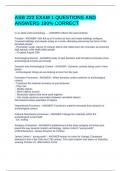Exam (elaborations)
ASB 222 EXAM 1 QUESTIONS AND ANSWERS 100% CORRECT
- Course
- Institution
ASB 222 EXAM 1 QUESTIONS AND ANSWERS 100% CORRECTASB 222 EXAM 1 QUESTIONS AND ANSWERS 100% CORRECTASB 222 EXAM 1 QUESTIONS AND ANSWERS 100% CORRECTIn an ideal world archeology... - ANSWER-reflects the past perfectly Pompeii - ANSWER--Ash fell up to 6 inches an hour and made buildings collapse; C...
[Show more]



